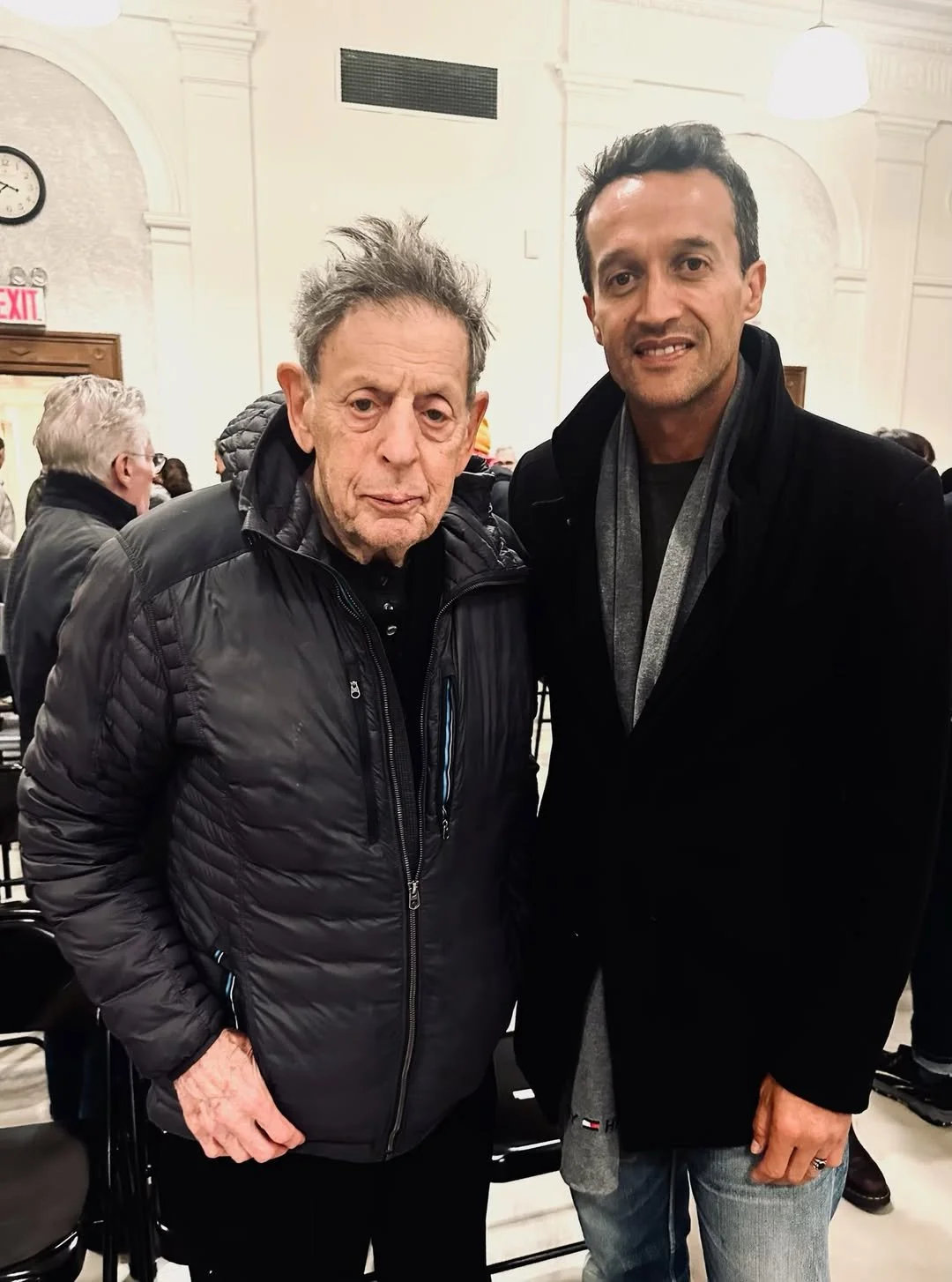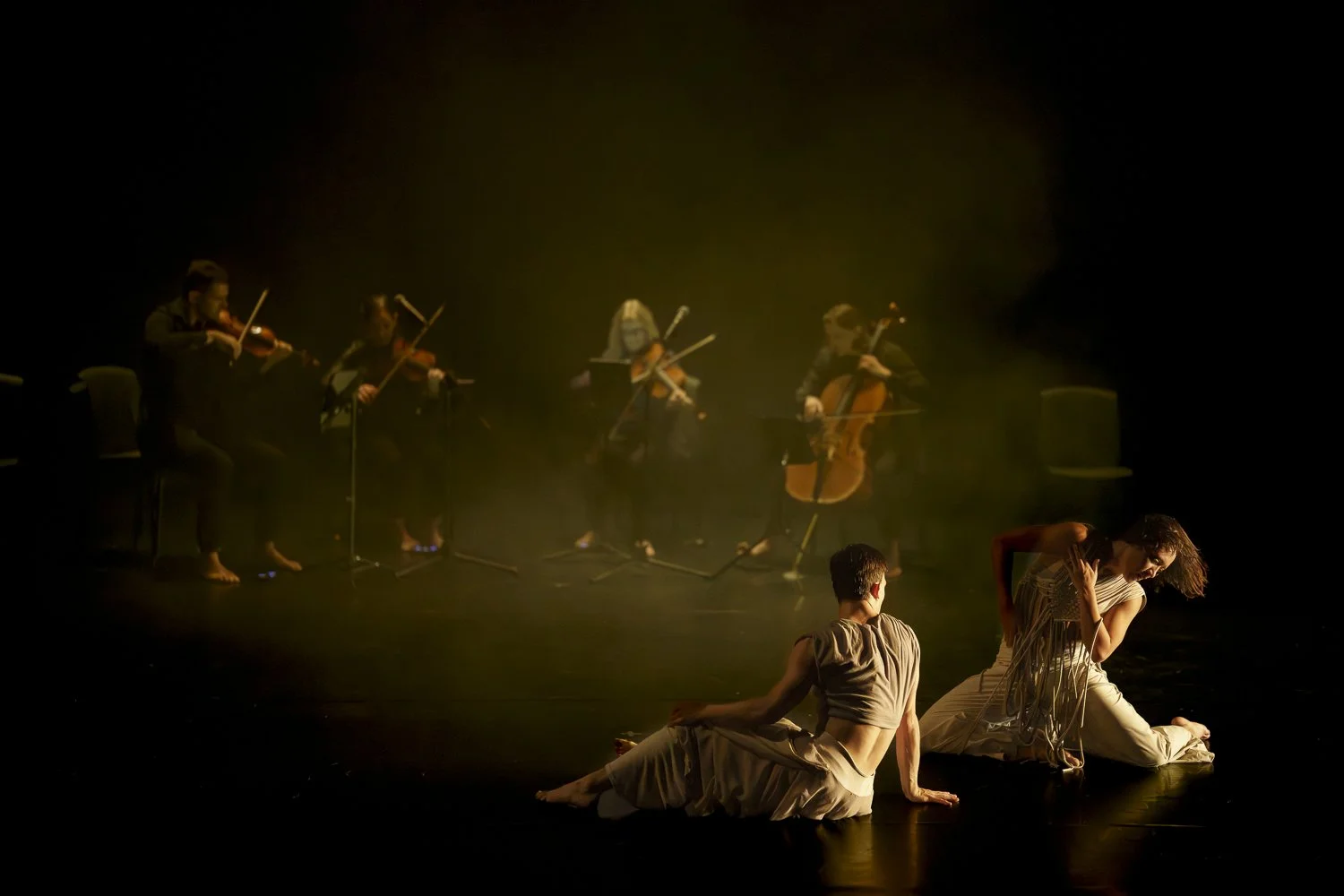100 Winds Taupō Hau Rau: musicians and dancers breathe together
Photo credit: John McDermott
Inspired by the shifting winds of Lake Taupō, 100 Winds Taupō Hau Rau is a compelling and moving new work, performed by the New Zealand String Quartet and a quartet of dancers from the New Zealand Dance Company. Developed by Chamber Music NZ in collaboration with NZDC and NZSQ, the overarching creative concept is by NZDC’s Artistic Director, acclaimed choreographer Moss Te Ururangi Patterson (Ngāti Tūwharetoa).
Choreographer Moss Te Ururangi Patterson (Ngāti Tūwharetoa)
Photo credit: John McDermott
The large audience in Te Papa’s Soundings Theatre falls silent as the house lights dim and the four musicians of the New Zealand String Quartet are gently illuminated one by one, sitting across the back of the stage. Dressed in black, barefoot, they begin the evening’s programme with Philip Glass’s String Quartet No 4, Buczak. The work was written in 1989 in memory of New York-based visual artist Brian Buczak, partner of Glass’s close friend Geoffrey Hendricks, who commissioned it after Buczak died, aged 33, from AIDS-related complications.
We are aware at once that the NZSQ (violinists Peter Clark and Monique Lapins, Gilian Ansell, viola and Matthias Balzat, cello) form a taut, well-balanced and cohesive ensemble. The first of the three movements is harmonically dense, with rocking chords and circling harmonic sequences, the textures sometimes leavened with pizzicato playing. A more plaintive second movement has soulful melodic lines and a nice duet between 1st violin and cello against repetitive accompaniment from the inner voices. All three movements are untitled, the third beginning and end with chordal passages, a soaring violin melody against chugging minimalism in between.
Philip Glass is known as a minimalist composer. What is minimalism? Much has been written in attempts to define it, but in summary its characteristics, evident in Glass’s music, are repetition, slowly shifting harmonies, steady and sometimes motoric pulses or rhythms, an absence of the goal-oriented direction found in western harmonies, and therefore a static quality, the music circling around itself. Glass and his fellow minimalists often focused on elements of music such as timbre, dynamics and textures to make subtle changes. There are melodic lines with lyrical beauty, often, as here, with repetitive accompaniments.
Composer Philip Glass and choreographer Moss Patterson met in New York City
Image credit: Chamber Music NZ
A key feature of this writing is the importance of the little shifts as the piece progresses. There’s no narrative here, just an invitation to listen closely to the music itself and the subtle changes within it. And herein lay a musical problem for me with this performance, especially during this first part of the evening, before the arrival of the dancers.
Glass’s quartets, like all chamber music, benefit from an intimate relationship between ensemble and audience. Soundings Theatre is a theatrical space and has an inevitably dry acoustic. Placing the Quartet at the back of the stage means amplification is necessary, and the nature of the amplification in this performance largely irons out musical subtleties, offering an overly homogeneous sonic texture.
The loss of the intimacy of chamber music becomes less important as the audience absorbs itself in the dance performance. The stage is almost completely dark as a chanting voice is heard, a karakia, intoning the themes of the production in te reo Māori and English. Patterson describes 100 Winds as “a reflection on identity, change and connection.” In creating the work, he was “inspired by the wisdom of my elders and the cultural knowledge passed down through generations”, and his work “explores how the winds were once described in stories, ancient, and full of meaning.”
Light creeps in from the side, and a white-clad male dancer enters, seeming to challenge the audience, accompanied first by a simple, repetitive cello line, joined in turn by the other instruments. This second part of 100 Winds uses Philip Glass's String Quartet No 2, Company, drawn from music written for a dramatization of a short novel by Samuel Beckett.
The dancer extends a wooden object, as he confronts the audience. It could be a weapon but proves to be a wooden pūrerehua, a whirler or "bull-roarer", whirled around the head on a string, adding a strong, ancient, mysterious sound to the music of the quartet. Three more dancers join the first, their movements undulating and flowing, music and dance working well together. Shifting relationships between the four musicians, as melodies and leadership move among the ensemble, are similar to the shifting roles of the four dancers as they perform in duos and trios.
Photo credit: John McDermott
The use of the breath, and the sounds of breathing in the dance, are marvellously related throughout the performance to the overarching theme of winds. A powerful dance sequence exploring breathing evokes sounds and movements of haka, the musicians silent at first, the dancing close to the floor - the earth, perhaps, or the wind-tossed surface of the lake?
The atmosphere shifts when the four dancers turn to face the now standing musicians for a compelling performance of Steve Reich’s famous Clapping Music, instruments set aside, eight pairs of hands performing this challenging repetitive work. (Reich’s work, originally written for two performers, is a minimalist icon – I have the app on my phone, and it requires great concentration and precision.)
Choreography to Steve Reich’s Clapping music
Photo credit: John McDermott
After a complete clapping sequence, the dancers turn away and the musicians continue clapping to their fierce rhythmic dance, dancers sometime stamping, haka-like, punctuated with grunts and shouts. The choreography here responds directly to the musical pulse and impetus. The musicians express the rhythms with their bodies as they clap, and the dancers are passionate to the end, finally leaving the stage one by one.
100 Winds ends with a dance choreographed to Glass’s 6-movement String Quartet No 3, 'Mishima', originally written as a score for a film about Japanese writer Yukio Mishima. It begins in silence, breathing at first the only sound. A solo female dancer, skilfully whirling the pūrerehua, is joined by others, who take the instrument from her as she dances on. Dancers and musicians weave and flow, like winds and waters, the dancers spinning and whirling like characters in a mysterious narrative, the music a background to their story. The melancholy mood of the first two movements changes to an atmosphere somehow more extrovert and energetic. The musicians of the quartet are a tight unit, the dancers also closely entwined.
In silence, the dramatic entry of a male dancer, moving slowly with a woman on his shoulders, has the appearance of an ancient gigantic creature, morphing as he is reverently laid on the ground, while she moves his limbs. The musicians begin to play, slowly and quietly at first and then as the music picks up speed, so does the dance, the two bodies closely woven together.
With the music now repetitive and urgent, all four dancers are on stage, some watching as others dance, the pūrerehua returning as the intensity of both the music and the dance increases. The work eventually ends quietly, dancers moving to sit alongside the musicians, the final movement of Glass’s Quartet soft and full of sighing nostalgia, motoric rhythms coasting to a stop.
The ending of 100 Winds Taupō Hau Rau
Photo credit: John McDermott
The enthusiastic ovation suggested the audience greatly appreciated the work. For me, it was an emotionally strong and beautifully shaped creation, but I felt the collaboration served the dance more strongly than the music. There was a pervasive sense that the NZSQ was an on-stage accompaniment to the dance rather than creative partner to the work’s structure and trajectory.
Chamber Music NZ has so far presented only three performances of 100 Winds. It could, however, be a great show for some of Aotearoa’s arts festivals, perhaps with further exploration of on-stage placement of the musicians and an acoustic more grateful for live chamber music.
Chamber Music New Zealand: 100 Winds Taupō Hau Rau New Zealand String Quartet, New Zealand Dance Company, Moss Te Ururangi Patterson (choreography and design), Peter Clark & Monique Lapins (violins), Gillian Ansell (viola), Matthias Balzat (cello), ‘Isope ‘Akau’ola, Eden Kew, Caterina Moreno & Anya Down (dancers). Ella Madsen Brough (lighting design). Wellington, 5 April 2025.






